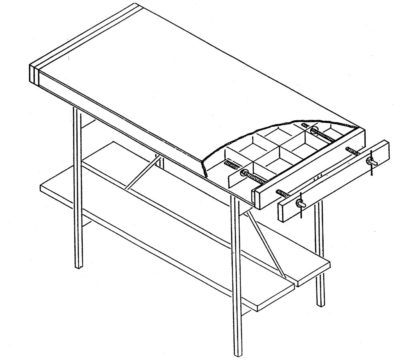Workbench Wednesday — Bench #2 , 1990, Part 1
This is the next of an occasional series on the workbenches I’ve built over the years. — DCW
=======================================================
By the late 80s not only was my young career at the Smithsonian humming along but my outside work for private clients was keeping me as busy as I wanted to be. An awful lot of those projects were “on site.” Whether the client was a private collector or an institution, with increasing frequency I was working at their location. There are many reasons for this; cramped quarters at home, the legal liability of transporting very valuable objects, the cost of renting a truck and hiring someone to help out (I usually work alone), etc. Regardless of the cause I often found myself working in unfamiliar, and usually unequipped, surroundings.
Thus, several times a year I would move lock, stock and “workbench” (saw horses and plywood or door) to a new location, a truly onerous activity. One project in particular, in a museum’s sub-basement down three flights of a spiral staircase, provoked me to build a high-performance lightweight folding workbench that remained in use for many years before retiring to the deck o serve as a serving table when I cut back on my on-site work. I have improved on both the design and execution of the bench in recent years but for now I will stick to the 1989 prototype and the 1990 finished bench.
This growing commitment to on-site work justified a little investment of my time to work out the problems inherent in occupying space that was not my own. In the end, that process of finding a “better way” resulted in the design and fabrication of a new workbench and some companion accessories to make the task of working in a portable studio more manageable and productive.
What did I want?
The only thing I was sure of was that my sawhorse and plywood routine had to go. But what arrangement was to take its place? Being a lazy fellow, my first actions were to look around at the market to see if any of the available “portable” workbenches were suitable.


I discovered only two real options; a small, pseudo knock-down version of the European-style butcher-block-top bench, or a Workmate. I looked at a couple of the former, and own one of the latter. I found the portable Eurobenches to be too small and unsteady for my use (and quite frankly, too “cheezy”). In addition, they still weighed-in at around 100 lbs. Since I would have to carry it by myself, it was simply too heavy. I tried my Workmate on a couple of projects, but it wasn’t exactly what I really wanted because it was too top-heavy and the work surface was too small. My search for a manufactured bench to suit my needs wasn’t exhaustive, but nevertheless, I decided to design and build my own portable workbench.
The process of procuring a new, high performance portable workbench began with the question of exactly what I wanted out of the bench, regardless of its source. When I decided to make my own, I had only to review those requirements and build to fit them. Back to the original question, what were my specifications for the bench? The answer was simple; 1) the top had to be perfectly flat and about 2’x 4′ (any smaller and I might as well stick to my Workmate, much larger and it would have been unwieldy for some of the pathways I had to traverse), 2) it had to have a vise sturdy enough to take a modest beating, 3) the bench had to be very light, compact, and easy to set up and take down because I didn’t want to have to assemble a kit each time I moved, and 4) it couldn’t cost a fortune in time or money to acquire. It was also important to remember that the bench wouldn’t have to stand up to immense weight or stress, since the pounding necessary during general joinery was rarely required in a conservation project. Any particularly heavy work dictated by a specific treatment would still have to be done at home.

The bench I ended up with was not an example of exquisite handworked joinery, but it did require precise machine woodworking techniques. The bench shown here is my second version and still not perfect, but it is completely functional and does satisfy the requirements listed above. It might be bragging but I think it remains the finest high performance portable bench design I have encountered to date.
The top is the right size for my needs at the time (although it could be made any size), and contains a pair of 24″ twin-screw face vises at the ends which opened about 12″. The bench folds up into a compact unit weighing only about 50 lbs., making it extremely easy to move about. In fact, the lightness presented another problem which I will describe later on. The long diagonal braces, which fold with the legs, provide plenty of stability to the bench allowing even more aggressive cutting and pounding than I had hoped for. In addition, I built several accessories which enhanced my capabilities for restoration on-site. Finally, in terms of both fabrication time and materials cost, the bench was very inexpensive. It took about six well-planned hours and $75.00 worth of materials to build, plus about $25 of machine-shop time (in 1990 dollars). You can fancy it up as much as you want, but you can have the basic unit quickly and inexpensively.
Next time — the “proof of concept” prototype



Join the Conversation!